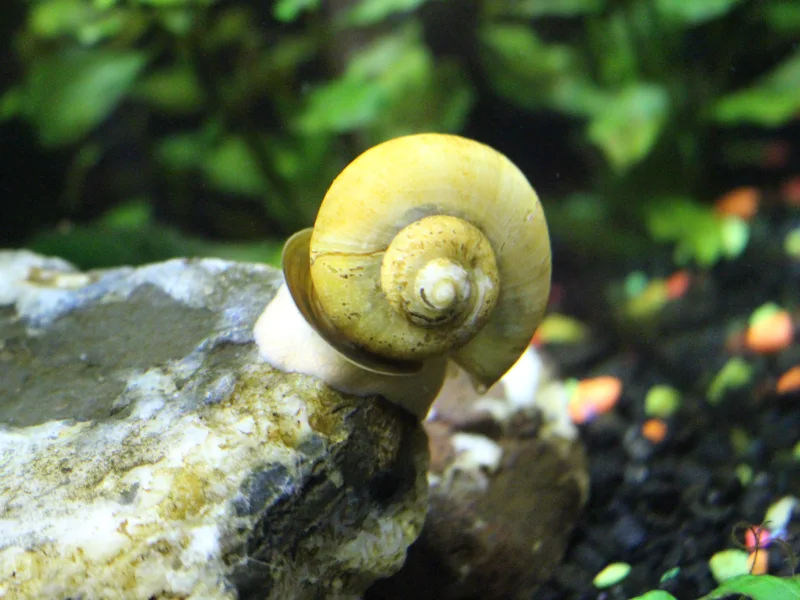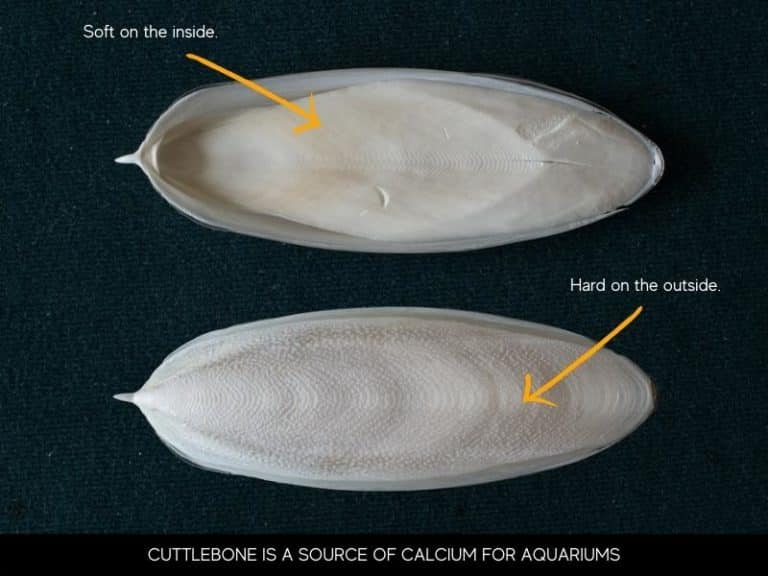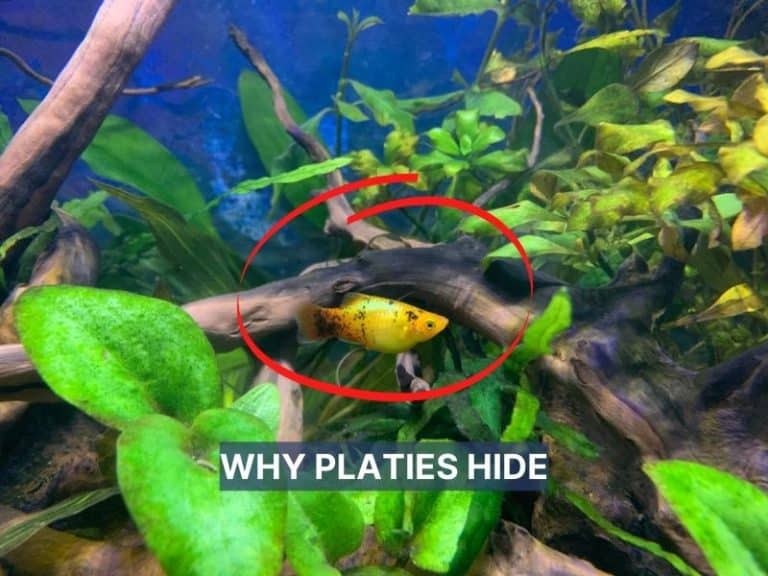I always recommend checking the health of a snail before buying one. In fact, it is the first step to identifying why your snail is not moving and won’t come out of the shell. If you have a nerite or mystery snail, there’s no need to worry if it isn’t moving because that’s quite normal. Your snail should live for up to three years under optimal conditions. But why is the snail not moving?
Usually, a snail will not move or come out of the shell due to low temperature. Nerites and mystery snails thrive in temperatures between 76°F and 84°F. A decrease in temperature forces them into hibernation. But below 23°F, your snail will die. If it’s too cold, place the snail in warm water to encourage it to come out of the shell and move.
A snail can also remain inactive while starving or adapting to a new aquarium.
After keeping mollusks for over four years, I learned that sometimes a snail might just be sleeping. This article will share seven reasons your snail might not be moving. I have also put together proven tips to fix the problem.
Why is my snail not moving?

A snail sitting in one spot for a long time may not be in distress or unhealthy. The behavior is likely normal in some cases except when the snail is dead in its shell. Either way, you want to be sure there isn’t any problem by checking on it.
Here are some reasons why your snail is not moving:
| Reason for Not Moving | Best Fix |
| Hibernation | Allow the snail time to hibernate naturally. |
| Starvation | Feed your snail twice a day |
| New tank | Acclimate snails before adding them to a new tank. |
| Low temperatures | Improve tank temperature to 76°Fto 84°F. |
| Poor water quality | Cycle 25% of the water every week. |
| Illness | Check and treat illnesses and injuries. |
Hibernation
In aquariums, nerite and mystery snails often remain inactive for days. You can distinguish a hibernating snail from a dead one by looking at its shell. A dead snail’s shell appears discolored, lifeless, and weightless.
The snail slime remains active in hibernation mode and keeps the snail attached to surfaces. However, dead snails lack the sticky slime and are more likely to detach from any surface and float away. Don’t be quick to throw away your snail anyway. Give it time to awaken.
Pro tip: A snail in hibernation will remain in one spot, won’t come out of its shell, but will remain attached to a surface. In contrast, a dead snail cannot attach to any surface and will remain motionless.
Starvation
A starved snail will not move or come out of its shell. Extreme starvation could even kill them. Food scarcity means snails do not get enough energy for metabolism—their metabolism declines to conserve the little energy they have.
Inadequate food makes snails less active, tired, and sleepy. If your snail has not eaten anything for the last one or two weeks, starvation could be the reason it is inactive.
Adaptation to a new tank
New snails can take about three days to adjust to your tank’s conditions. If you just brought a new snail home and realized it is not moving or coming out of the shell, perhaps it is still adapting to the new environment. Introducing snails to the water of different chemical properties from the one they came in subjects them to stress.
If you put them in your tank too soon before they acclimate to the new tank conditions, your snails might become inactive or die.
In the next section, I’ll guide you on acclimate your snails to a new tank appropriately.
Extreme temperatures
Icy temperatures are the main reason for snails not moving or coming out of shells. The lower the temperatures, the more dormant your snails will become.
Snails have glycerol in their blood, which acts as an antifreeze. Therefore, nerite and mystery snails can be alive but inactive in cold water. However, the glycerol is ineffective when temperatures drop below 23°F.
Prolonged exposure to extremely low temperatures can send your snail to hibernation or even kill it.
Unstable water quality
Ammonia and nitrites must not be present in your aquarium. The level of both compounds in your tank should read zero parts per million. If your snails are not moving, you should also be worried about the level of nitrates in your aquarium. Keep nitrates below 40 parts per million.
Note: Apple and mystery snails are quite sensitive to changes in water quality. If your mystery snail is floating or immobile for too long, you might want to check the water condition.
Continuous breakdown of organic materials inside the aquarium lowers the pH over time, disturbing water quality. Check that your aquarium pH is not below 7. The acidity may stress your snail and force it not to come out of the shell.
Your snail is sick or injured
Perhaps your snail is sick or injured, and that’s why it has refused to come out of its shell. Snails may harbor diseases from where you bought or collected them from.
If you put snails and aggressive tank mates like bettas together, the snails can suffer significant injuries on their antennae. An injured or sick snail will not move or come out of the shell.
The snail is sleeping
Snails can sleep for days. If two or three days have passed since your snail came out of its shell, panic is unnecessary. You can tell that a snail is sleeping if its shell hangs slightly away from its body or its antennae appear slightly withdrawn.
Sleeping snails often hold on to substrates or the aquarium surface. The snail will wake up with a jolt of energy to keep itself most active at night.
How long can a snail go without moving?
Snails can hibernate for up to three years without moving in the wild. But in the aquarium, a snail can remain inactive for about one or two weeks. If you transfer new snails from one aquarium to another, the snail may not move for two to three days.
Newly introduced nerite snails, for example, will not move for days until they adapt to the new ecosystem. If the snail is not dead and you want it to move or come out and eat, you can encourage them with warm water. If the snail does not move, try the fixes below.
What to do to fix the problem
Here are some ways to help a snail that is not moving or coming out of the shell:
Keep temperatures between 76°F and 84°F
Snails such as apple and mystery snails are more active and lively at temperatures between 76°F and 84°F. If the room gets so cold at night, add a heater to your aquarium to stabilize the temperatures. Lukewarm water will encourage your snail to get out of the shell and move.
Ensure slightly alkaline water with a pH level between 7.8 and 8.4
Use a pH test kit to measure the pH level of your water. If the pH is below 7, dissolve one teaspoon of baking soda in a glass of water. Use the solution in a ten-gallon aquarium. Baking soda will help you achieve a slightly alkaline pH of 7.8 and 8.4 for your snails.
Increase your tank size
If depopulating your tank is a challenge, increase the tank size. The fewer the snails in a larger tank, the happier and healthier they are.
Also, the larger the tank, the easier it is to clean. If the aquarium is spacious enough, your snail will be less likely to hide in its shell for days.
Read my guide on how many snails you should keep in a 10-gallon tank here.
Enhance the water calcium content
Lack of enough calcium makes snail shells weak and delicate. If you don’t add calcium fast enough, the shock can traumatize and kill your snail. Snails need calcium levels of between 70 and 90mg/l. Add a calcium-based supplement such as cuttlebone or lime to your aquarium to give them strength and confidence to go about their snail business.
Change 25% of the water every week
Even if your water looks clear, waste and dissolved food particles are still present. Water change is essential for diluting toxins that can harm your snails.
Instead of changing all the aquarium water at once, change 25% of it every week until the water chemistry is restored to optimal levels.
Improve snail nutrition
Feed your snails at least twice a day with as much food as they can eat in about three minutes. Add some aquatic plants to your aquarium so the snails can graze. Also, buy the snails some algae wafers from the pet store and monitor their feeding habits at night when they are most active.
Choose suitable tankmates for your snails.
Remove and separate aggressive aquatic animals from peaceful and shy ones like snails. If you are keeping nerite snails, their best tankmates are barbs, guppies, and tetras. Leave two snails per five gallons of water.
Depopulate your aquarium
An overcrowded aquarium causes competition, aggression, and stress to snails. If your aquarium is overstocked with snails, the apple snail will not move or come out of the shell.
Is my snail dead or sleeping?
Here are some characteristics of dead and sleeping snails:
- Smell: A snail that has been dead for more than 12 hours smells particularly awful. On the other hand, a sleeping snail emits a fishy smell.
- Dull and weightless shell: The flesh of a dead snail shrinks in size, leaving the shell light and pale. However, a sleeping snail has weight and a brightly colored shell.
- Behavior: Use the tip of a pen to open the shell lightly. If the cover feels hard, your snail is sleeping. If the cover comes out without resistance, your snail might be dead.
- Empty shell: If you find an empty shell, your snail has been dead for days.
- Response to stimuli: An active snail should respond to external stimuli such as touch. A snail should retreat into the shell when touched. Otherwise, the snail is probably dead.
- Heartbeat: look at the snail’s heartbeat through light. If the shell is transparent enough, you should be able to see a snail’s heartbeat. A sleeping snail has a heartbeat. A dead snail does not.
MORE ABOUT SNAILS
References
- Aquarium Info. (2015) Apple Snail.
- Montana State University. (nd.). Snails.





